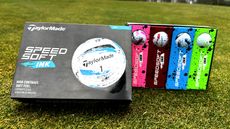Balls
Read up on reviews and ratings for golf balls from all the biggest brands. Find the perfect golf balls with the experts at Golf Monthly.
Despite their external similarities, when you peel away the covers most golf balls on the market differ greatly, offering different benefits for different types of golfers.
Golf ball buyers guide
Using the same premium ball in practice as you do in competition will heighten your feel for a more reliable short game. But which ball should you settle on? Here are our thoughts to help you whittle your options down. Urethane or Ionomer? The more expensive Urethane cover is softer and provides more feedback off the face, which should help you with your distance control. If you are unable to justify the steeper price tag of Urethane, cheaper Ionomer covered balls still provide plenty of feel for the average club golfer. Soft or firm? A few of the premium balls, like the Titleist Pro V1 and Srixon Z-Star, come in alternative versions, which spin slightly less for players who prefer a firmer feel and less spin off the tee. Try both types from tee-to-green to find your preference. Tee or green? Different brands have conflicting fitting messages. Brands like Bridgestone like to measure your swing speed and fit you for a ball that will give you more distance off the tee, while brands like Titleist base its fittings around your short game. So consider if your game will benefit most from extra yards off the tee or better distance control around the green. Budget or premium? Gone are the days when budget balls felt like rocks and looked just as bad. Nowadays you can get some reasonable quality for less than £20 a dozen. Again, test multiple ball types to see which you get the best results with.
Latest
-

PXG Xtreme Tour Golf Ball Review
Joe Ferguson investigates an interesting new golf ball release from PXG to see if this premium upgrade can deliver on its performance promises
By Joe Ferguson Published
-

Inesis Tour 900 Golf Ball Review
Joe Ferguson takes a look at the new three-piece urethane golf ball from Inesis…
By Joe Ferguson Published
-

Bridgestone Tour B RXS Golf Ball Review
Sam De’Ath tests the Bridgestone Tour B RXS golf ball on the golf course and analyses the performance on offer
By Sam De'Ath Published
-

Bridgestone Tour B RX Golf Ball Review
Sam De’Ath gives his verdict on the Bridgestone Tour B RX golf ball after putting it to the test on the golf course.
By Sam De'Ath Published
-

TaylorMade SpeedSoft Ink Golf Ball Review
Should the TaylorMade SpeedSoft Ink golf ball be your new ball of choice? Sam De’Ath puts it to the test on the course to find out
By Sam De'Ath Published
-

Bridgestone 2024 Tour B X Golf Ball Review
Joe Ferguson takes a look at Tiger Woods’ Bridgestone 2024 Tour B X golf ball...
By Joe Ferguson Published
-

Bridgestone 2024 Tour B XS Golf Ball Review
Joe Ferguson puts the Bridgestone 2024 Tour B XS golf ball to the test...
By Joe Ferguson Published
-

TaylorMade 2024 TP5x Golf Ball Review
Joe Ferguson takes a deep dive into TaylorMade’s most popular tour validated golf ball…
By Joe Ferguson Published
-

TaylorMade 2024 TP5 Golf Ball Review
We take a look at the newest version of the TaylorMade TP5 golf ball…
By Joe Ferguson Published
